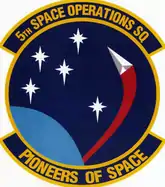5th Expeditionary Space Operations Squadron
The United States Air Force's 5th Expeditionary Space Operations Squadron is an expeditionary satellite operations unit, assigned to Air Force Space Command to activate or inactivate as needed.
| 5th Space Operations Squadron | |
|---|---|
| Active | 1989–1992; 1993–2000 |
| Country | |
| Branch | |
| Role | Satellite Operations |
| Part of | Air Force Space Command |
| Motto(s) | Scanning the Globe (1989-1994) Pioneers of Space (1994-present)[1] |
| Decorations | Air Force Outstanding Unit Award[2] |
| Insignia | |
| 5th Space Operations Squadron emblem (approved 9 December 1994)[2] |  |
| 5th Satellite Control Squadron emblem (approved 25 August 1989)[1] |  |
History
The 5th Expeditionary Space Operations Squadron (ESOPS) was formed by the Air Force Satellite Control Facility. The squadron was provisionally activated as Operating Location-A, 750th Space Group, on October 1, 1992. This satellite control facility was established as one of the Air Force's satellite operations locations. AFSCF was later divided into the 2nd Space Test Group and the Consolidated Space Test Center (CSTC)[3] on October 1, 1987, when AFSPC took over Onizuka Air Force Base, now Onizuka Air Station. OL-A encompassed the CSTC divisions of VOS, VOE, and VOD. The 5 ESOPS was officially activated 22 November 1993, under the 50th Operations Group and within one year, the 21st Space Operations Squadron (SOS) absorbed the roles of the 2nd Satellite Tracking Group Operations Division and the 1999th Communications Squadron Operations Division. After 1995 Base Realignment and Closure Committee directed the realignment of Onizuka AFS, the 21st SOS absorbed the roles of the 750th Space Group and all subordinate units and the 5th Space Operations Squadron.
Three weeks later in late 1993, the squadron activated as the 5th Space Operations Squadron and launched a DSCS III and a NATO IV communication satellite, supported NASA's Hubble telescope repair, and activated as the 5th Space Operations Squadron. The squadron has launched the IUS in support of NASA programs including all seven TDRS and three inter-planetary spacecraft: Galileo (Jupiter), Magellan (Venus), and Ulysses (Sun).
Lineage
- Constituted as the 5th Satellite Control Squadron on 11 April 1989
- Activated on 1 May 1989
- Redesignated as the 5th Space Operations Squadron on 30 January 1992
- Inactivated on 31 July 1992
- Activated on 22 November 1993
- Inactivated on 13 June 2000
- Redesignated as the 5th Expeditionary Space Operations Squadron and converted to provisional status on 5 December 2007[2]
Assignments
- 1000th Satellite Operations Group, 1 May 1989 – 31 July 1992
- 50th Operations Group, 22 November 1993 – 13 June 2000
- Air Force Space Command to activate or inactivate at any time after 5 December 2007[2]
Locations
- Fairchild Air Force Base, Washington, 1 May 1989 – 31 July 1992
- Onizuka Air Force Station, California, 22 November 1993 – 13 June 2000[2]
Satellites operated
- Defense Meteorological Satellite Program (1989 - 1992)
- Defense Satellite Communications System III (1993–1995)
- NATO III (1993–1995)[4]
- SkyNet IV (1993–1995)
- Inertial Upper Stage (1993–1995)
- Tracking and Data Relay Satellite
References
Notes
- Endicott, p. 364
- Robertson, Patsy (26 February 2008). "Factsheet 5 Expeditionary Space Operations Squadron (AFSPC)". Air Force Historical Research Agency. Retrieved 29 March 2018.
- Smith, David. "Consolidated Space Test Center Capability to Support Small Satellites".
- Force Enhancement - Air University
Bibliography
![]() This article incorporates public domain material from the Air Force Historical Research Agency.
This article incorporates public domain material from the Air Force Historical Research Agency.
- Endicott, Judy G. (1998). Active Air Force Wings as of 1 October 1995 and USAF Active Flying, Space, and Missile Squadrons as of 1 October 1995 (PDF). Air Force History and Museums Program. Washington, DC: Office of Air Force History. ASIN B000113MB2. Retrieved 2 July 2014.
